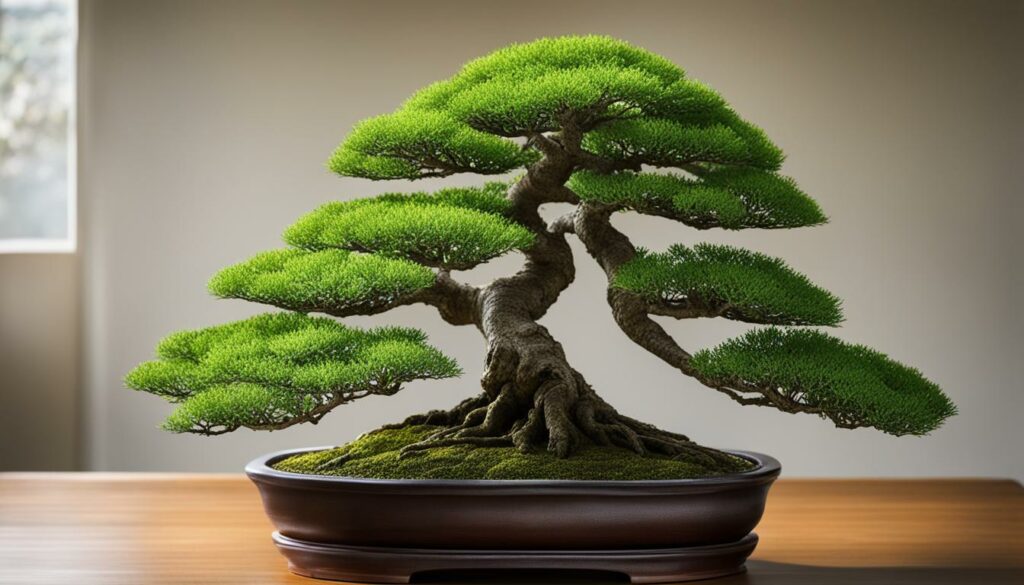If you’re drawn to the art of bonsai, you’ve likely encountered the striking beauty and serenity of the Zelkova bonsai. This elegant Japanese elm is a popular choice among bonsai enthusiasts, known for its refined aesthetic and tranquil presence. In this article, we’ll delve deeper into the Zelkova bonsai species, from its origins and characteristics to essential care tips and display options. Whether you’re a seasoned bonsai gardener or just beginning your journey, you’re sure to appreciate the artistry of the Zelkova bonsai.
Key Takeaways:
- Zelkova bonsai is a popular species known for its elegant aesthetic and tranquil presence.
- Originating from Japan, the Zelkova tree is a deciduous species that has become a beloved choice among bonsai enthusiasts.
- Proper care is essential for maintaining the health and beauty of your Zelkova bonsai, from watering and pruning to training and repotting.
- Displaying your Zelkova bonsai can be just as important as caring for it, with various options available, including traditional bonsai stands and outdoor settings.
- Zelkova bonsai has a deep cultural and symbolic significance in Japanese culture, representing serenity and harmony.
Introduction to Zelkova Bonsai
Welcome to the world of Zelkova bonsai, a stunning deciduous tree species native to the Eastern Hemisphere. Zelkova is commonly known as the Japanese elm, a name derived from its resemblance to the native elm tree of Japan. This elegant bonsai tree has gained popularity among enthusiasts due to its graceful appearance, adaptability, and ease of care.
The Zelkova tree belongs to the family Ulmaceae and typically grows tall in its natural habitat. As a bonsai tree, however, it can be pruned and trained to take on various shapes and sizes, all while maintaining its characteristic smooth gray bark and tiny, serrated leaves.
So what makes Zelkova bonsai stand out? For starters, it has a small, rounded canopy that creates a beautiful silhouette. Its trunk develops interesting fissures and coloring over time, adding to its unique aesthetic. Additionally, the Zelkova tree’s foliage color ranges from bright green in the spring and summer to a rich red or yellow in the fall, creating a natural masterpiece that changes with the seasons.
Explore the art of Zelkova bonsai and discover how this beautiful tree species can bring a touch of elegance and serenity to your life.
Choosing the Right Zelkova Variety
Choosing the right Zelkova variety is crucial for creating a successful bonsai. Before deciding on a specific variety, consider the tree’s unique features and growth habits to ensure it aligns with your project goals.
When selecting a Zelkova variety, some factors to consider include:
- Size: Determine the final size you desire for your bonsai and select a variety that meets those requirements. Japanese zelkovas are typically larger than Taiwanese or Korean varieties, so keep this in mind when making your selection.
- Bark: The bark of Zelkova trees varies considerably in texture and color. For example, the Sawleaf Zelkova has bark that peels in thin strips, while the Musashino variety has a smooth, cork-like texture.
- Leaf size: Consider the overall size and shape of the leaves when selecting a variety. Smaller leaves are more suitable for smaller bonsai trees and can accentuate the intricacy of the tree’s design. The smaller the leaf, the more densely they will grow.
- Fall color: The vibrant autumn foliage of the Zelkova tree is a sought-after feature in bonsai. Japanese Zelkovas typically have a deep red color in autumn whereas the Sawleaf has a yellow-orange fall color.
Zelkova Varieties Comparison Table
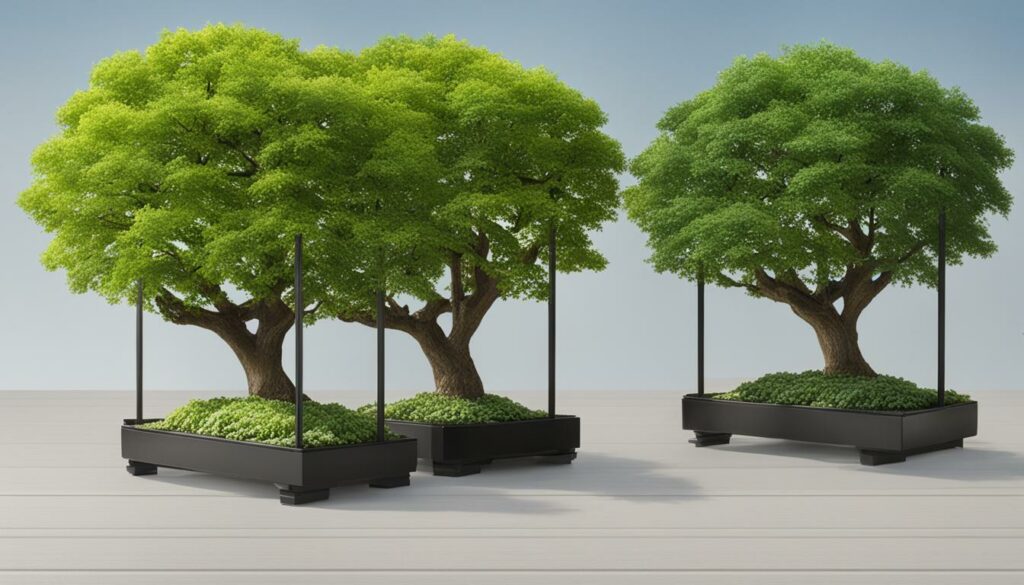
| Variety Name | Size | Bark Texture and Color | Leaf Shape and Size | Fall Color |
|---|---|---|---|---|
| Japanese Zelkova | large | grayish, smooth | oval, 4-6 inches | deep red |
| Taiwanese Zelkova | medium | gray, scaly | 3-5 inches | purple-bronze |
| Korean Zelkova | small | light brown, exfoliates | 3-4 inches | yellow, bronze |
| Sawleaf Zelkova | medium | brown, exfoliates in thin strips | small, 1-2 inches | yellow-orange |
When choosing the right Zelkova variety, take the time to research and make an informed decision. Remember, the selection of your bonsai tree impacts not only the tree’s growth and overall look, but also your ability to properly care for it in the future.
Zelkova Bonsai Care Tips
Proper care is essential for the health and beauty of your Zelkova bonsai. Follow these care tips to ensure your bonsai thrives:
Watering
Water your Zelkova bonsai regularly, but make sure the soil is not waterlogged. Check the soil moisture level frequently to avoid over- or under-watering. The frequency of watering depends on the size of the bonsai and its location. In summer, you may need to water it more often than in winter.
Pruning
Pruning is essential for maintaining the shape and size of your Zelkova bonsai. Use sharp and clean pruning tools to trim the branches and roots. Keep an eye out for dead or damaged branches and remove them promptly. Prune your bonsai in spring or fall when new growth is visible.
Fertilizing
Feed your Zelkova bonsai with fertilizer during the growing season to promote healthy growth. Use a balanced fertilizer with equal parts of nitrogen, phosphorus, and potassium. Do not fertilize your bonsai during the dormant season.
Positioning
Zelkova bonsai prefers bright, indirect sunlight and moderate temperatures. Avoid placing it near drafts, air conditioning vents, or heaters. When placing your bonsai indoors, make sure the room has enough natural light and airflow.
Tip:
Always use sterile tools to prune your Zelkova bonsai and avoid transmitting diseases.
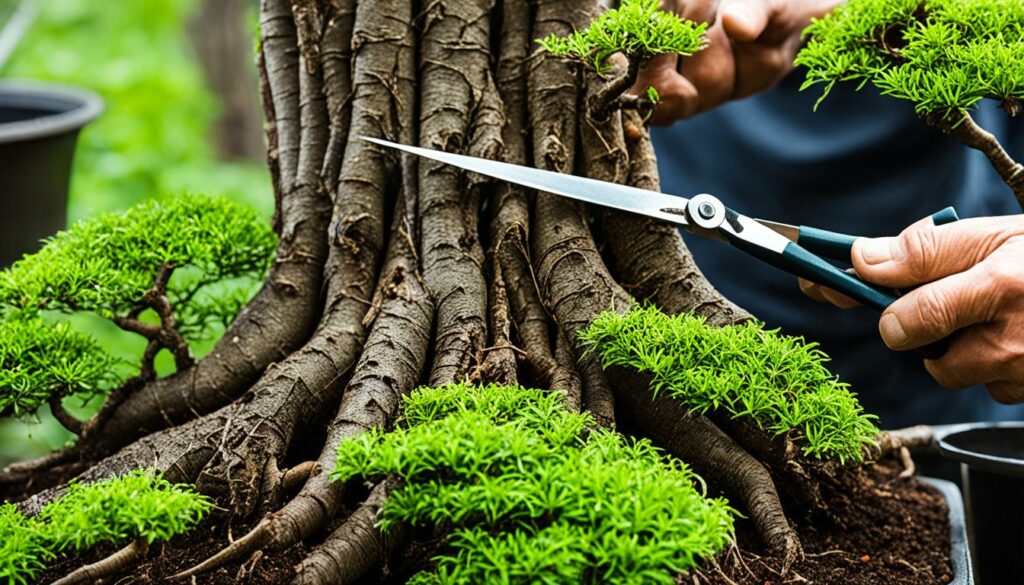
| Care tips | Description |
|---|---|
| Watering | Water regularly but avoid over-watering. Check soil moisture frequently. |
| Pruning | Prune in spring or fall to maintain shape. Remove dead or damaged branches promptly. |
| Fertilizing | Use balanced fertilizer during growing season. Don’t fertilize during dormant season. |
| Positioning | Place in bright, indirect sunlight. Avoid drafts and extreme temperatures. |
Training Techniques for Zelkova Bonsai
For a stunning Zelkova bonsai, training and shaping is essential. Here are some techniques to help you achieve the desired aesthetic qualities:
- Wiring: Using wire to gently shape and direct the growth of your Zelkova bonsai. It’s important to avoid wrapping the wire too tightly to prevent damage to the limbs or bark. Make sure to remove the wire once the branches have set into the desired position.
- Pruning: Removing unwanted or dead branches to enhance the overall design and shape of your bonsai. Always use proper pruning techniques, such as sterilizing your tools and making clean cuts.
- Pinching: Pinching the buds or new growth with your fingers to encourage branching and a fuller appearance. Make sure not to overdo it and damage the healthy buds.
- Clamping: Clamping larger branches to create interesting curves and bends in the trunk. Be careful not to clamp too tightly and cause irreparable damage to your Zelkova bonsai.
To create an artistic masterpiece with your Zelkova bonsai, you can combine these techniques to achieve unique and stunning designs.
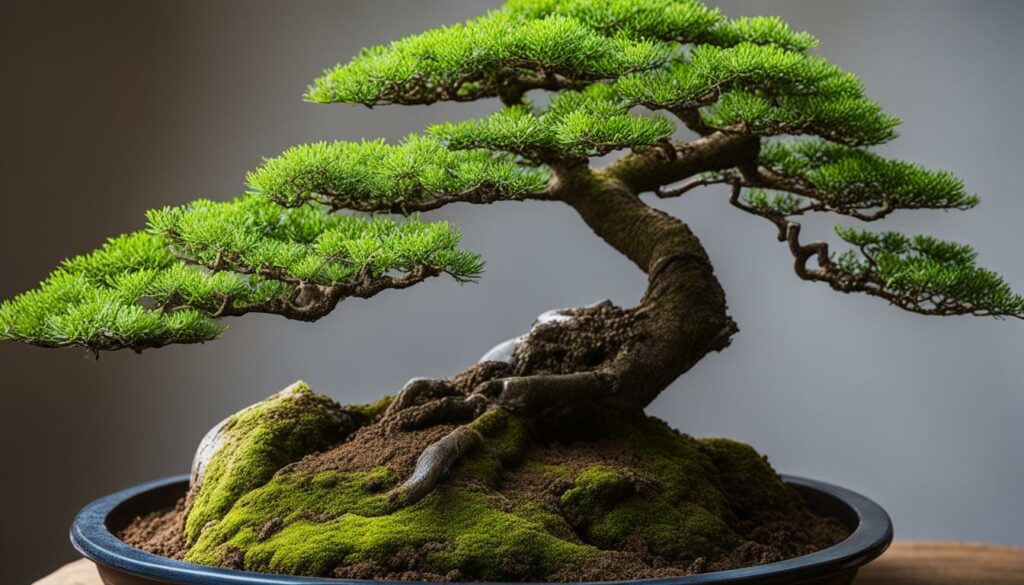
“Remember to always consider the natural growth patterns of your Zelkova tree when shaping and training. The best bonsai designs work in harmony with the tree’s inherent nature.”
Zelkova Bonsai Repotting Guide
Repotting is essential for maintaining the health and development of your Zelkova bonsai. The frequency of repotting varies depending on the age and growth rate of the tree. Younger trees may require more frequent repotting to promote growth, while older trees will need repotting less often.
When it is time to repot your Zelkova bonsai, gently remove the tree from its current pot. Carefully prune the roots, removing any damaged or tangled roots. Use a well-draining soil mix that suits your Zelkova bonsai’s needs. The soil mix should be slightly acidic, with a pH range of 6.0-6.5.
Fill the pot with a layer of soil, ensuring it is level and even. Re-position your Zelkova bonsai in the pot and secure it with a wire if necessary. Add more soil mixture, filling the pot to the top. Press the soil down firmly and water the tree until the water comes out of the drain holes.
Place your repotted Zelkova bonsai in a shaded area for a few weeks, allowing the roots time to recover. During this time, remove any dead leaves and keep the soil moist.
After the recovery period, gradually introduce your Zelkova bonsai to more sunlight. Avoid fertilizing immediately after repotting as the tree needs time to recover.
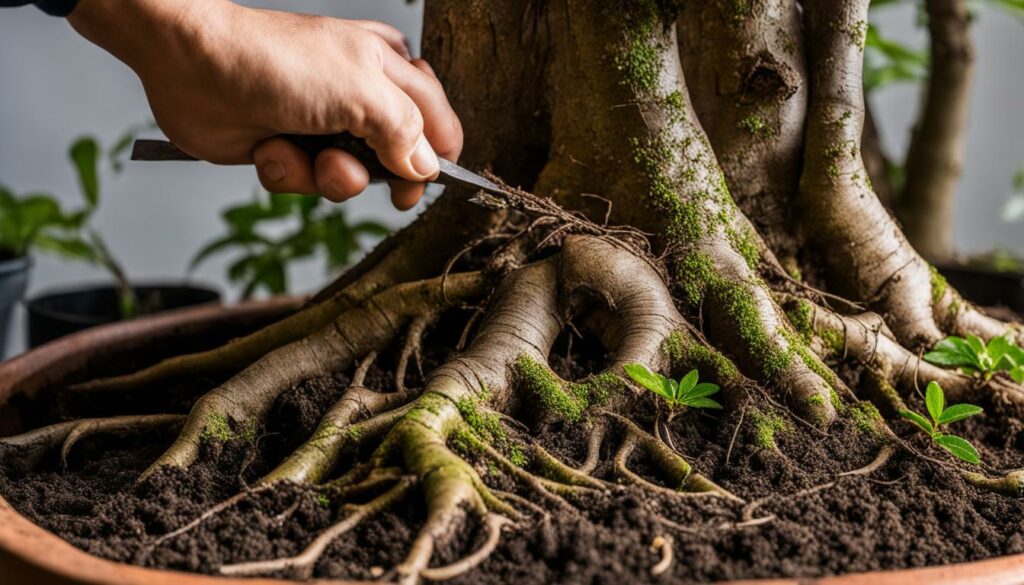
Repotting your Zelkova bonsai may seem daunting, but with careful attention and following the proper steps, it can be a rewarding experience that contributes to the health and longevity of your bonsai tree.
Common Pests and Diseases for Zelkova Bonsai
Despite being a hardy plant, Zelkova bonsai is vulnerable to pests and diseases. These can stunt growth, cause discoloration, and even lead to death if left untreated. Identify and address any problems promptly to ensure your bonsai remains healthy and thriving.
Pests
Common pests for Zelkova bonsai include:
| Pests | Signs of Infestation | Treatment |
|---|---|---|
| Spider Mites | Webbing, yellowing leaves, and speckling | Use a miticide and increase humidity around the plant |
| Scale Insects | Sticky secretions on the plant and yellowing leaves | Use a horticultural oil to smother the insects |
| Fungus Gnats | Small, dark insects and slow growth | Allow the soil to dry out before watering and use a sticky trap to catch the gnats |
Regularly inspect your Zelkova bonsai for signs of infestation. Catching problems early can prevent the spread of pests to other plants in your collection.
Diseases
Zelkova bonsai are susceptible to several diseases. These include:
- Root Rot
- Leaf Spot
- Powdery Mildew
To prevent diseases, ensure your bonsai is in well-draining soil and avoid overwatering. If you suspect your plant has a disease, remove any affected leaves or branches and treat with a suitable fungicide.
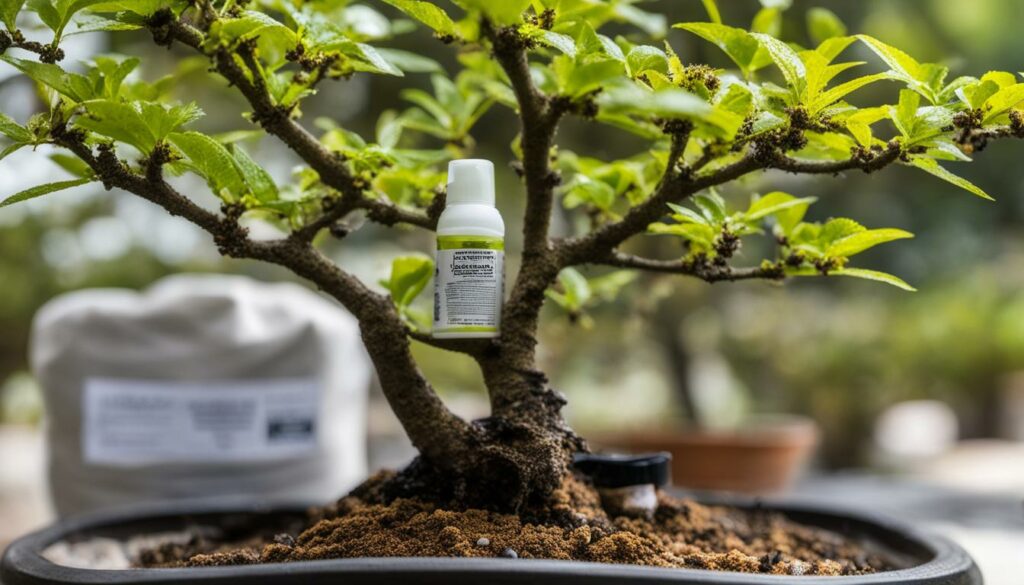
Maintaining the health of your Zelkova bonsai is key to creating a peaceful and serene atmosphere in your bonsai garden.
Displaying Your Zelkova Bonsai
Once you have nurtured your Zelkova bonsai to its full glory, it’s time to display it in a fitting manner. The beauty of Zelkova bonsai lies in its simplicity and understated elegance. A clean and minimalistic display that does not detract from the tree’s natural charm is the ideal setting.
You can choose from several display options that suit your taste and preferences.
Traditional Bonsai Stands
A traditional bonsai stand is a classic display option that showcases the bonsai tree’s natural beauty. These stands come in various designs and materials, such as wood, ceramic, and stone. Choose a stand that complements your Zelkova bonsai’s size, shape, and color.
Outdoor Settings
Outdoor settings, such as a garden, patio, or balcony, provide a natural and refreshing backdrop for your Zelkova bonsai. Place it in an area with ample sunlight and breezy airflow. Natural light helps the tree maintain its health and vibrancy, while a gentle breeze can carry away any pests or pollutants.
Indoor Displays
If you are displaying your Zelkova bonsai indoors, choose a bright and spacious area that is away from direct sunlight or heat sources. You can place it on a windowsill, mantelpiece, or side table to add a touch of nature to your interior decor.
Group Displays
Zelkova bonsai looks beautiful in group displays, where multiple trees are arranged together in harmony. You can create a mini-forest, rock garden, or penjing display using various bonsai species, shapes, and sizes.
Whatever display option you choose, make sure it reflects your love and respect for your Zelkova bonsai. Display it with pride and appreciation, and it will bring you years of beauty and serenity.
Zelkova Bonsai Styles
Part of the allure of Zelkova bonsai is its ability to be shaped and trained into numerous styles, each eliciting a unique aesthetic. By using different techniques and care strategies, you can transform your Zelkova bonsai into a true work of art.
Some common Zelkova bonsai styles include:
| Name | Description |
|---|---|
| Formal Upright | An elegant, straight style with a tapering trunk and a well-defined apex. |
| Informal Upright | A natural appearance with a curved trunk and an unstructured apex. |
| Cascade | A dramatic and striking style that has branches that trail down below the container. |
| Semi-Cascade | A gentler cascade style, where the branches also extend below the container, but not as much as in the full cascade style. |
| Slanting | A distinctive style in which the trunk is slanted, often in a windswept and natural-looking angle. |
| Broom | A distinctive style that looks like a broom with a wide and flat crown. |
Each style requires specific techniques and care, but experimenting with different styles can result in an exquisite, personalized Zelkova bonsai tree. With dedication and patience, you can train and shape your bonsai into a stunning masterpiece.
Zelkova Bonsai Exhibition
If you’re looking for inspiration and appreciation of Zelkova Bonsai, explore the world of bonsai exhibitions. Bonsai enthusiasts display their skill and artistry at various events across the country, showcasing their mastery of this refined art form.
Renowned bonsai shows like the National Bonsai Exhibition and the US National Arboretum Bonsai and Penjing Museum bring together some of the most exquisite examples of Zelkova Bonsai from around the world. At the exhibition, you’ll have the opportunity to admire a variety of Zelkova Bonsai styles and learn about the history and techniques behind their cultivation.
On a smaller scale, local bonsai clubs and societies organize events and shows, displaying their members’ Zelkova Bonsai. Such events provide an excellent opportunity to connect with fellow enthusiasts and gain insights into the nuances of Zelkova Bonsai cultivation from local experts and enthusiasts.
Highlight: 2019 Zelkova Bonsai Exhibition
| Event | Location | Date |
|---|---|---|
| 2019 Zelkova Bonsai Exhibition | Portland Japanese Garden, Oregon | September 21-22, 2019 |
A must-see exhibition is the 2019 Zelkova Bonsai Exhibition at the Portland Japanese Garden in Oregon, showcasing over 100 Zelkova Bonsai trees in different styles and sizes.
“The exhibition is a wonderful opportunity for the public to see this beautiful and intricate art form, and to appreciate the time and dedication it takes to cultivate such delicate and serene creations,” said exhibition organizer Jane Smith.
Make sure to visit a Zelkova Bonsai exhibition near you to witness the beauty and skill of this refined and serene art form.
Zelkova Bonsai: Symbol of Serenity
One of the most significant aspects of Zelkova bonsai is its cultural and spiritual meaning. In Japanese culture, Zelkova bonsai is considered a symbol of serenity and harmony. The art of bonsai itself is deeply rooted in Japanese philosophy and spirituality, focusing on the balance between nature and man.
Zelkova bonsai embodies this philosophy with its graceful beauty and tranquil presence. The art of cultivating a Zelkova bonsai requires patience, attention, and care, much like the practice of meditation. The act of tending to your bonsai tree can be meditative, helping you find peace and connection with nature.
Beyond its physical beauty, Zelkova bonsai represents a deeper meaning that connects us with nature and ourselves. The art of bonsai offers us the opportunity to slow down and appreciate the beauty of life, reminding us to find balance and harmony in all aspects of our lives.
“The bonsai tree is a symbol of peace, harmony, and balance, reminding us to take care of ourselves and the world around us.” – Unknown
Conclusion and Final Thoughts
Cultivating a Zelkova bonsai is a rewarding and fulfilling experience that requires dedication and care. As you have learned throughout this article, the Zelkova bonsai is a stunning and elegant tree species with a rich history and cultural significance in Japanese culture.
By choosing the right Zelkova variety, practicing proper care techniques, and training your bonsai with the right techniques, you can transform your Zelkova into a work of art that reflects your personal aesthetic.
Whether you choose to display your Zelkova bonsai indoors or outdoors, the proper display can enhance its beauty and evoke a sense of tranquility in your space.
Finally, we hope this article has provided valuable insights and inspired you to cultivate your own Zelkova bonsai masterpiece. With patience, dedication, and a love for the artistry of bonsai, you can create a stunning and serene addition to your home or garden.
In conclusion, the Zelkova bonsai is a unique and rewarding tree species to cultivate, and we hope you have found this article informative and helpful in your bonsai journey.
FAQ
What is Zelkova bonsai?
Zelkova bonsai refers to the art of cultivating and shaping Zelkova trees, specifically the Zelkova species, also known as Japanese elm, into miniature, refined versions. These bonsai trees exhibit the same graceful beauty and structure as their larger counterparts, but on a much smaller scale.
What are the characteristics of the Zelkova tree?
The Zelkova tree, commonly known as Japanese elm, is a deciduous tree native to Eastern Asia. It is known for its elegant, sweeping branches, small serrated leaves, and attractive bark. Zelkova trees have a moderate growth rate and can reach heights of up to 50 feet when grown in their natural environment.
How do I choose the right Zelkova variety for my bonsai?
When choosing a Zelkova variety for your bonsai project, consider factors such as the desired size, leaf shape, and overall aesthetics. Some popular Zelkova varieties for bonsai include Zelkova serrata, Zelkova nire, and Zelkova musashino. Each variety has its unique characteristics, so it’s essential to research and select the variety that aligns with your vision.
What are some care tips for Zelkova bonsai?
Proper care is crucial for the health and beauty of your Zelkova bonsai. Ensure your bonsai receives adequate sunlight, regular watering, and appropriate fertilization. Prune your Zelkova bonsai to maintain its desired shape, and consider repotting it every few years. Additionally, protect your bonsai from extreme temperatures and keep an eye out for common pests and diseases.
How do I train my Zelkova bonsai?
Training your Zelkova bonsai involves techniques such as wiring, shaping, and pruning to create the desired aesthetic. Use bendable wires to gently guide the branches into the desired positions and shapes. Regular pruning helps maintain the bonsai’s form and encourages new growth. Remember to exercise patience and allow your Zelkova bonsai to gradually develop into your desired design.
When and how should I repot my Zelkova bonsai?
Repotting is essential for the overall health and development of your Zelkova bonsai. Ideally, repot your bonsai during spring before new growth begins. Carefully remove the bonsai from its pot, trim the roots, and replace the soil with a well-draining bonsai soil mix. After repotting, provide proper care and monitor your bonsai’s recovery.
What are common pests and diseases that affect Zelkova bonsai?
Zelkova bonsai can be susceptible to pests such as aphids, spider mites, and scale insects. Diseases like powdery mildew and root rot can also affect the health of your bonsai. Regularly inspect your bonsai and take preventive measures such as proper sanitation and regular pest control. If needed, consult with a bonsai expert to address any potential issues.
How should I display my Zelkova bonsai?
Displaying your Zelkova bonsai is an important aspect of showcasing its beauty. Consider using traditional bonsai stands, such as suiseki or jita, to elevate and present your bonsai. Outdoor settings like gardens or patios provide a natural backdrop for your Zelkova bonsai. Experiment with different display options to find the setting that highlights your bonsai’s aesthetic appeal.
What are some popular Zelkova bonsai styles?
Zelkova bonsai can be trained and shaped into various styles, including formal upright, informal upright, cascade, and windswept. Each style creates a distinct visual impact and reflects different aesthetics. Research and study various bonsai styles to determine the style that resonates with your artistic vision and highlights the unique features of your Zelkova bonsai.
Are there any bonsai exhibitions specifically for Zelkova bonsai?
Bonsai exhibitions provide a platform for bonsai enthusiasts to showcase their skills and admire the artistry of others. While there may not be specific exhibitions solely dedicated to Zelkova bonsai, you can attend general bonsai exhibitions where Zelkova bonsai trees may be featured. These exhibitions offer an opportunity to appreciate the mastery and craftsmanship of Zelkova bonsai artists.
What does Zelkova bonsai symbolize?
Zelkova bonsai holds significant symbolic value in Japanese culture. It represents serenity, harmony, and the balance between nature and human intervention. Cultivating and caring for a Zelkova bonsai can provide a deep sense of tranquility and connection to the natural world. It is a reminder to appreciate the beauty of simplicity and the artistry of nature.
